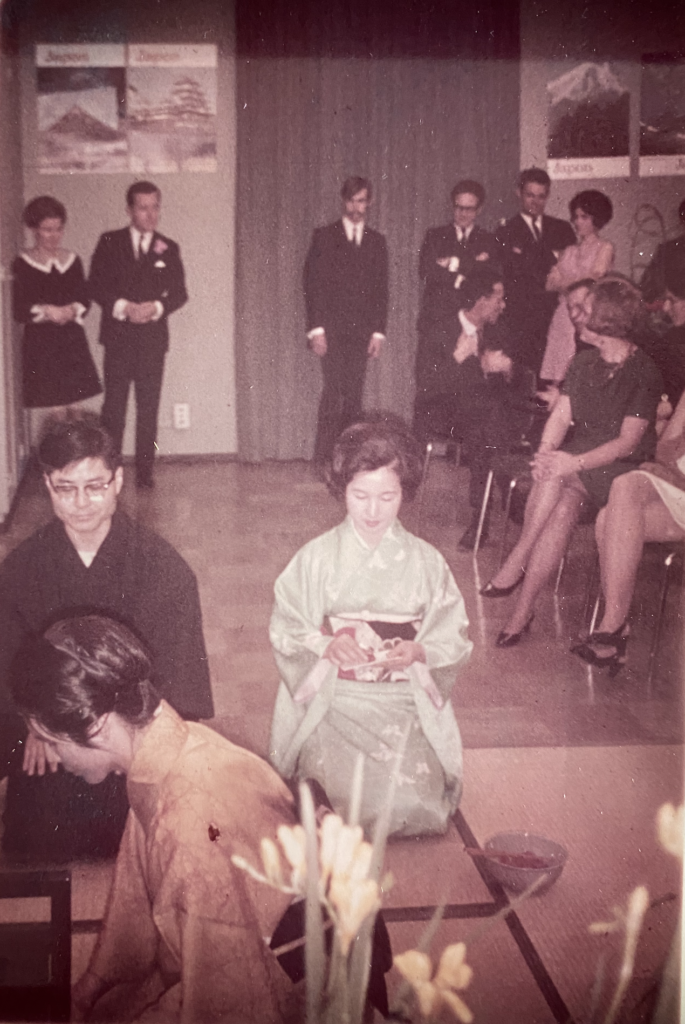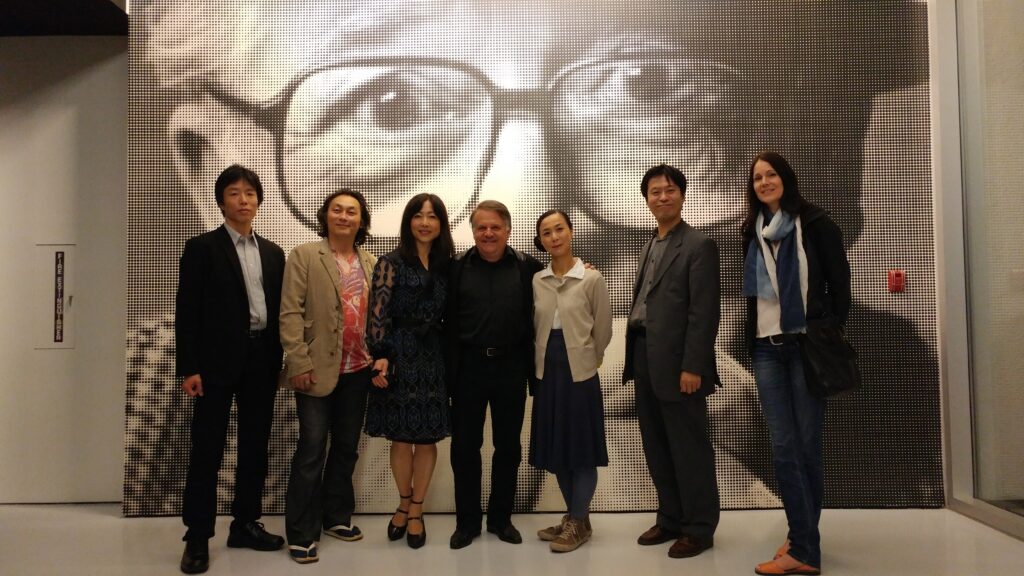I lived in Japan for the first half of my life, except for a couple of years when my family and I stayed in Switzerland. Then, I moved to the U.S. in my twenties for education and work. My entire family still lives in Japan today, but I will most likely spend the rest of my life in the U.S., where I have my new family, friends, and colleagues. When I moved to this country, I didn’t know how long I would stay. Many years later, I still love visiting Japan and especially seeing my family there, but I feel more at home in the U.S. I teach Japanese literature and film at Hamilton. I study various “stories” because I am interested in different narrative strategies the writers, benshi live oral narrators, and filmmakers adopt in their particular context. For that reason, I will tell my story here by reflecting on my encounters with “stories” in my life.
I was born in Kobe to a middle-class family and spent my childhood in Kobe and Yokohama. My father is from shitamachi (lower-middle-class neighborhood) of Tokyo. After college, he worked as a “sararīman” (white-collar salaried worker) for forty years. Then he started business counseling on his own. My mother was a daughter of a Buddhist priest, but she went to a catholic women’s college. That seemed to have been a pivotal moment for her to think about the relationship between religions and people. She worked for a couple of years after college and then married my dad and became a homemaker, just like many young women at the time.

When I was in kindergarten, my dad’s company sent him to a business school in Switzerland, so my mother and I moved there to join him. At our departure, my grandparents came to see us off at the Tokyo International Airport with a gift: a three-volume set of picture books about how ancient Japanese gods created Japan. Before the internet and online shopping age, those three picture books became the only Japanese stories I read during our stay in Geneva. I loved how the tales portrayed gods as regular people who did good and bad things and sometimes made mistakes. I read the stories repeatedly until I almost memorized all episodes of various gods, their happiness, and sad events. Many years later, I realized that those stories came from Kojiki, which is believed to be the oldest extant Japanese literature from the early eighth century. The stories were officially compiled to explain the origin of Japan and the authenticity of its divine imperial lineage. This piece of information finally helped me understand the context. This children’s version of the national myth was on a best-seller list several years earlier. So, my grandparents might have heard that the then crown princess read these picture books to her son, and they perhaps hoped that the stories would help their granddaughter understand her roots even when she was going to grow up in the West. I wonder what it meant to my grandparents and many other people in Japan to be “Japanese” a couple of decades after Japan’s defeat in WWII and the Occupation Period.
After we returned to Japan, I was busy playing outside with my friends and siblings. But I also loved reading books and manga when I was alone. (I would have also enjoyed watching movies and anime at home if they were available, but DVDs and streaming services did not exist.) So, in elementary school, I volunteered as a student librarian. When I was not helping other students check out books, I read Maurice Leblanc’s Arsene Lupin stories. By the time I finished all thirty volumes, I had fallen in love with the titular character, the most fantastic gentleman thief! Next to the Lupin books in the library was a 27-volume collection of the “Boy Detectives” stories by a Japanese mystery writer, Edogawa Rampo. (If you know Bungo Stray Dog or Detective Conan, you probably recognize Rampo and his work.) Little did I know that I would become a scholar of Japanese detective fiction and write about Rampo and other mystery writers. As a scholar, I realized that the Lupin series that I enjoyed so much was, in fact, a Japanese rewrite of Leblanc’s work. In the process of producing an abridged version of the Leblanc work for Japanese children, the Japanese translator quite freely added or omitted episodes. I also learned that Edogawa Rampo borrowed ideas from Western mystery stories, though ingeniously creative at the same time. Then, another write re-wrote Rampo’s novels into the abridged version for young readers. Learning about the different versions of the same work made me contemplate the meanings of transcultural and translingual “translation” and “adaptation” and their powerful narratives even though they were not the “original” stories.
After we returned to Japan, I was busy playing outside with my friends and siblings. But I also loved reading books and manga when I was alone. (I would have also enjoyed watching movies and anime at home if they were available, but DVDs and streaming services did not exist.) So, in elementary school, I volunteered as a student librarian. When I was not helping other students check out books, I read Maurice Leblanc’s Arsene Lupin stories. By the time I finished all thirty volumes, I had fallen in love with the titular character, the most fantastic gentleman thief! Next to the Lupin books in the library was a 27-volume collection of the “Boy Detectives” stories by a Japanese mystery writer, Edogawa Rampo. (If you know Bungo Stray Dog or Detective Conan, you probably recognize Rampo and his work.) Little did I know that I would become a scholar of Japanese detective fiction and write about Rampo and other mystery writers. As a scholar, I realized that the Lupin series that I enjoyed so much was, in fact, a Japanese rewrite of Leblanc’s work. In the process of producing an abridged version of the Leblanc work for Japanese children, the Japanese translator quite freely added or omitted episodes. I also learned that Edogawa Rampo borrowed ideas from Western mystery stories, though ingeniously creative at the same time. Then, another write re-wrote Rampo’s novels into the abridged version for young readers. Learning about the different versions of the same work made me contemplate the meanings of transcultural and translingual “translation” and “adaptation” and their powerful narratives even though they were not the “original” stories.

Fast-forward to September 2001; I was a Ph.D. student at an American university studying Japanese literature and early 20th-century mass media (film, radio, and magazines). A liberal arts college in Ohio hired me as an interpreter to assist a group composed of people from Hiroshima and Nagasaki for a week. I worked closely with a hibakusha (survivor of atomic bomb explosions), Nagano-san. She told her stories about A-bomb in Nagasaki by visiting a college and local schools. I translated them into English. Not all hibakusha in Hiroshima and Nagasaki became “kataribe” (storyteller). Some never felt comfortable talking about their traumatic experiences, and others went through different phases. After remaining silent for many years, Nagano-san decided to tell her story in person because she did not want anybody else to experience what she had gone through. While Nagano-san’s story belonged to her as an individual, her audience related to her. After the group had fruitful visits at schools, we were getting ready to go to the Cleveland Airport to fly to NYC and visit the United Nations. On the morning of Sept 11, I turned on T.V. in my hotel room and saw the moment of the second plane crashing into the WTC twin tower. I hurriedly went downstairs and saw our group and other hotel guests staring at a T.V. screen in the hotel lobby. At some point, one guest said: “We should bomb the enemy.” Who is the enemy? Who is attacking whom and why, and what can we do to make sense of something incomprehensible that we see on the T.V. screen right now? The story in our contemporary world may be getting even more complex, despite that some people in power will always try to tell a simple and easy-to-understand view of the world.

Hamilton College, as a community, has its own distinctive identity. But the community is also made up of many different “stories” that each of us brings to the banquet table. We see/hear/read stories and might think we understand them, but learning more about the context may change our understanding of the stories. In that sense, stories may not be static or passive. I hope that this website will provide a venue where we can express ourselves, exchange thoughts, and work on help to build a more inclusive community.

